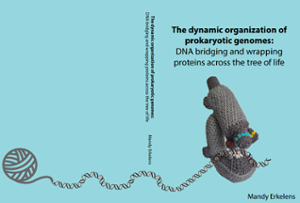Dissertation
The dynamic organization of prokaryotic genomes: DNA bridging and wrapping proteins across the tree of life
Every organisms in the tree of life faces the same challenge: the length of its DNA exceeds the volume of the cell it needs to fit in. Several strategies have evolved to solve this problem, one of them being the expression of proteins that bind and organize the DNA.
- Author
- A.M. Erkelens
- Date
- 27 September 2023
- Links
- Thesis in Leiden Repository

The best-known examples are the histone proteins of eukaryotes, but many other proteins have the same function. In this thesis I focused on bacterial and archaeal DNA organizing proteins, especially the ones that can bridge and/or wrap DNA. In bacteria, H-NS-like proteins have important functional and structural properties. The protein Rok from Bacillus subtilis is similar to H-NS in its DNA bridging behavior, but responds differently to environmental conditions. We propose that this is due to the different charge distribution. Archaea express histone proteins, like eukaryotes, but a more primitive version, reflective of their position in the tree of life. We investigated model archaeal histones and the effect of DNA sequence on hypernucleosome formation. Also, we looked at several other archaeal histones with different tails. A tail can have an effect on the DNA binding mode of the histone, switching from DNA wrapping to DNA bridging.
